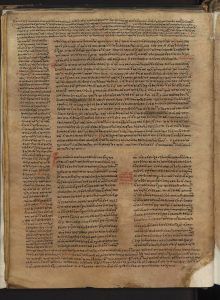Ambr. A 181 sup., f. 14v
F. 14v contains the beginning of Iliad 2.494–531, preceded by the corresponding hypothesis—a brief introductory summary outlining the subject matter of each canto—pertaining to the so-called Boeotia, the Catalogue of Ships, which constitutes the second part of the second book of the Iliad (2.494–877). This folio exemplifies all the characteristics of the textual and paratextual layout to which the scribe adhered consistently throughout the manuscript. The hypothesis is inscribed occupying a full page; the Homeric text is arranged in two columns; and the scholia are disposed in a marginal frame along the upper, outer, and lower margins, executed in a smaller script. The cross-references between text and scholia are primarily indicated by Greek numerals restarting from one on each folio: these numerals are written in red ink, as are the scholia in the intercolumnar space, the initial letters of each scholion, and certain enlarged letters set in ekthesis — see in particular the enlarged initial beta adorned with rudimentary phytomorphic ornamental strokes. The layout of the scholia is notably meticulous and carefully calculated: all scholia are contained within the folio, from α´ (1) to ιδ´ (14), and the text of the final scholion does not exceed the boundaries of the folio, as evidenced by the lower margin where the scholion concludes, marked by the conventional sign of two dots followed by a dash.
Dimensions: writing surface: 280 × 193 mm; writing surface of the poetic text: 233 × 155 mm; intercolumnar space: 20 mm; blank margins: upper margin 10 mm, lower margin 23 mm, outer margin approximately 15 mm (variable due to the rightward tapering of the scholia column), inner margin 30 mm.


